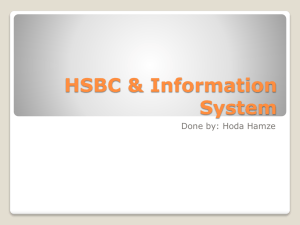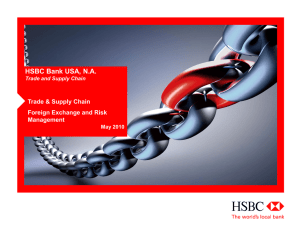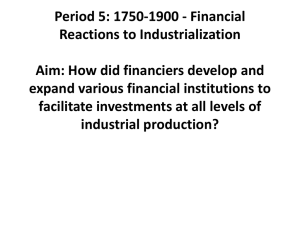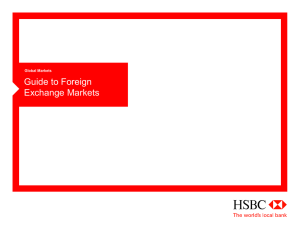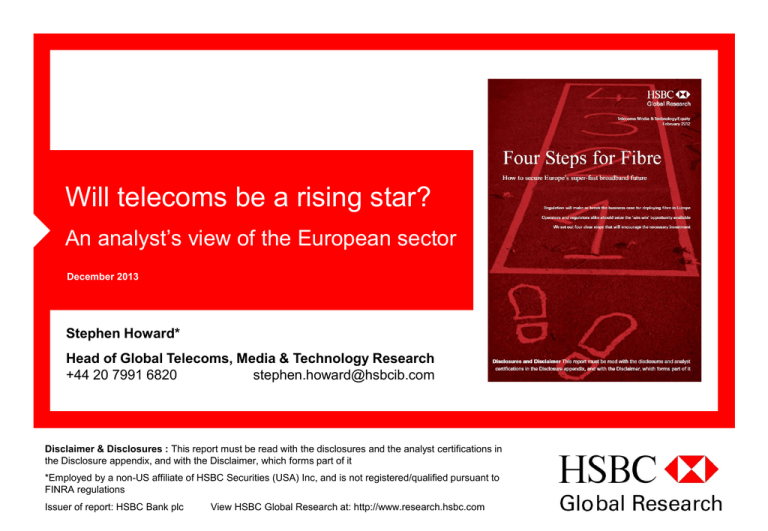
Will telecoms be a rising star?
An analyst’s view of the European sector
December 2013
Stephen Howard*
Head of Global Telecoms, Media & Technology Research
+44 20 7991 6820
stephen.howard@hsbcib.com
Disclaimer & Disclosures : This report must be read with the disclosures and the analyst certifications in
the Disclosure appendix, and with the Disclaimer, which forms part of it
*Employed by a non-US affiliate of HSBC Securities (USA) Inc, and is not registered/qualified pursuant to
FINRA regulations
Issuer of report: HSBC Bank plc
View HSBC Global Research at: http://www.research.hsbc.com
The European telecoms sector is under immense pressure
European telecoms is much more fragmented than its international peers
Europe
US
Japan
Source: HSBC, Datastream (1 October 2013)
2
Leverage high
Not only is telecoms leverage* higher in Europe vs Rest of World…
Source: Company reports, HSBC estimates
* Ratio of net debt (total debt less cash) to EBITDA (earnings before interest, tax, depreciation & amortisation)
Europe: DT, Orange, Telefonica, TI, BT, KPN, Telenor, TeliaSonera
3
Profitability trends deteriorating
…but profitability (EBITDA*) trends are much worse…
– Ratings agencies look at debt levels in conjunction with profitability trends
– As profitability declines, operators ability to support debt progressively undermined
Source: Company reports, HSBC estimates
* 5-year compound growth rate in EBITDA (earnings before interest, tax, depreciation & amortisation)
4
Revenue trends dreadful
…as are trends in revenues*…
– Negative revenue trends give investors & ratings agencies grave cause for concern
Source: Company reports, HSBC estimates
* 5-year compound growth rate in group revenues
5
Dividends cut
…and dividends have already been slashed in response
Source: Company reports, HSBC estimates
6
Capex trends weaker
Capex* weaker than international peers
– Note that capex/sales ratios quoted in isolation can be misleading
– Europe’s sales are contracting, whereas international peers’ sales are growing
– Hence, even if capex/sales ratios uniform, implies European capex declining vs peers
Source: Company reports, HSBC estimates
* Capex indexed 2006 = 100, international = US + Japan
7
Fibre deployment slower
Europe lags international peers in the roll out of fibre…
Source: Company reports (Q2 2013), HSBC estimates
8
LTE adoption slower
…and in the uptake of LTE
Source: GSMA (2012)
9
Telecoms investors have suffered poor returns for over a decade…
Telecoms share price performance since
January 1999 (Eurostoxx 600) rebased to 100
350
300
250
200
150
Total market: +5%
100
50
Telecoms: -57%
Jan-13
Jan-12
Jan-11
Jan-10
Jan-09
Jan-08
Jan-07
Jan-06
Jan-05
Jan-04
Jan-03
Jan-02
Jan-01
Jan-00
Jan-99
0
Source: Thomson Reuters Datastream, DJ Stoxx
10
…and now there’s the risk the economy will suffer from a lack of fibre
Progress vs Digital Agenda targets
Source: European Commission
11
The fixed-line recommendation: a fresh agenda in European telecoms
Frees incumbents to set own NGA prices until 2020(+)
– Enables operators to create innovative packages to better mine the consumer surplus
– Copper a partial substitute and priced low enough to stop any over-charging of NGA
– Regulatory focus not on price cuts but on wholesale-based competition/equivalence
Positive pricing signals to help convince investors
– Halts the automatic decline in ULL (and thus also downstream retail broadband) prices
– Improved top-line trajectory will give investors more confidence to back the industry
– Better copper pricing supports better NGA pricing and hence NGA investment case
Fully embraces principle of technology agnosticism/neutrality
– FTTP the most capable technology, but very expensive and deployment time lengthy
– FTTN (ie FTTC) to receive equally supportive regulation as FTTP
– FTTN much more cost-efficient and adequate to meet foreseeable bandwidth demands
12
Four steps for fibre
Simple 4-point plan to secure investment in NGA
Free operators to set their own prices for wholesale NGA
Provide positive pricing signals to convince sceptical investors
Continue adherence to the principle of technology agnosticism
Liberate national regulators to consider needs of network investment
13
Investor feedback
Investors see recent regulatory proposals as move in the right direction…
– Our thanks to all the investors/CEOs/politicians/regulators with whom we’ve met
– Investors have been keen to talk with regulators to understand developments
– Regulators have been interested to hear about financial markets’ concerns
…but most still see telecoms as unattractive for the time being
– Don’t underestimate the challenge: a material minority see telecoms bankruptcy risk
– All cite as issues declining revenues, excessive competition, obstacles to consolidation
– Anxious that more positive regulation will not be implemented ‘on the ground’
Investors loathe to back investment unless see rising ARPUs & revenues
– While revenues shrink (NB mobile as well as fixed), expect further capital withdrawal
– Proposed ‘carrots’ are long term: risk there’s not enough to win earlier investor support
– Many (most) would prefer to wait 2-3yrs to see some growth & rebuild trust in telecoms
14
Key items of unresolved investor uncertainty
Questions over implementation
– Is there disagreement both between bodies within the EC and beyond it with BEREC?
– Will all NRAs go along with the new proposals, or will there be local deviations?
– What are the risks of ‘opportunism’ once investors’ capital has been committed?
Questions especially over mobile and also over content
– How can operators spare the capital to invest when mobile doing so badly?
– Can mobile market structure be addressed (given already such rivalry from WiFi, OTT)?
– When will content market rigidities be tackled to facilitate IPTV-driven NGA uptake?
Questions about the new telecoms single market measures
– Can spectrum reform proposals gain support & address one prominent risk factor?
– Will net neutrality regulation give operators sufficient scope to charge for prioritisation?
– Could the relevant market review process see certain market segments deregulated?
15
Achieving a win win win win win win (win6) scenario via Moore’s Law
Prices will fall whatever happens – the only question is how
– Value-for-money gains bigger from new technology than pricing existing services lower
– Cf candle vs light bulb: no candle price cut can match a light bulb’s value for money!
– Customer best served by growth environment promoting investment in latest platforms
Needs of incumbents, altnets & cable operators can all be addressed…
– Incumbents: will invest more in fibre & mobile upgrades once can demonstrate benefits
– Altnets: opportunity to up-sell NGA-based services to their customer base at a premium
– Cable operators: supportive investment context will (in time) stimulate additional build
…while benefits are clear for consumers, regulators & politicians
– Consumers: economic growth plus better value-for-money of services that can do more
– Regulators: Europe could finally start to close 10-year technology deficit vs US & Asia
– Politicians: macro stimulus via investment in key infrastructure not needing tax funding
16
Scale and consolidation – cross-border and in-country
Either Europe builds scale to invest or others will do it for us
– Even largest European players have been investing slower than global peer group…
– …and are also divesting European assets, increasing the market’s fragmentation…
– …creating entry point for global players e.g. Mexico’s AMX or possibly US RBOCs
European market is fragmented, contracting and under-investing
– Given the ongoing process of convergence, European telecoms is very fragmented
– Need to take fuller account of platform-based competition (e.g. WiFi) & role of OTT
– Single market proposals/dynamic efficiency arguments help legitimise in-country deals
To address this fragmentation will involve some in-country consolidation
– Investors usually hostile to telecoms cross-border acquisitions, e.g. FT/TeliaSonera
– Bitter experience that cross-border deals are challenging, with high execution risks
– Without an in-country dimension to M&A, creation of cross-border scale will not happen
17
Summary: how telecoms can become attractive again
Investors still loathe telecoms: Q. Why does this matter? A. Investment
– When will investors push for network spending? When see rising ARPUs & revenues
– Hard for operators to justify spending: (i) fixed line & mobile consistently contracting
– (ii) fragmented market structure, especially given platform competition (eg WiFi) & OTT
Single market can deliver a more supportive investment environment
– Focus on dynamic not static efficiency gains & reflect breadth of competition (incl. OTT)
– Need consolidation, with in-country/x-border in parallel given overlaps/investor hostility
– Would address capex/scale gap of Europeans vs global players (otherwise are targets)
Prices will fall whatever happens – the only question is how
– New technology gives bigger value-for-money gain than lowering existing services price
– Cf candle vs light bulb: no cut in candle prices can match a light bulb’s value for money!
– Customer best served by growth environment promoting investment in latest network
18
Disclosure appendix
Analyst Certification
The following analyst(s), economist(s), and/or strategist(s) who is(are) primarily responsible for this report, certifies(y) that the opinion(s) on the subject
security(ies) or issuer(s) and/or any other views or forecasts expressed herein accurately reflect their personal view(s) and that no part of their compensation
was, is or will be directly or indirectly related to the specific recommendation(s) or views contained in this research report: Stephen Howard
Important disclosures
Equities: Stock ratings and basis for financial analysis
HSBC believes that investors utilise various disciplines and investment horizons when making investment decisions, which depend largely on individual
circumstances such as the investor's existing holdings, risk tolerance and other considerations. Given these differences, HSBC has two principal aims in its
equity research: 1) to identify long-term investment opportunities based on particular themes or ideas that may affect the future earnings or cash flows of
companies on a 12 month time horizon; and 2) from time to time to identify short-term investment opportunities that are derived from fundamental,
quantitative, technical or event-driven techniques on a 0-3 month time horizon and which may differ from our long-term investment rating. HSBC has
assigned ratings for its long-term investment opportunities as described below.
This report addresses only the long-term investment opportunities of the companies referred to in the report. As and when HSBC publishes a short-term
trading idea the stocks to which these relate are identified on the website at www.hsbcnet.com/research. Details of these short-term investment opportunities
can be found under the Reports section of this website.
HSBC believes an investor's decision to buy or sell a stock should depend on individual circumstances such as the investor's existing holdings and other
considerations. Different securities firms use a variety of ratings terms as well as different rating systems to describe their recommendations. Investors should
carefully read the definitions of the ratings used in each research report. In addition, because research reports contain more complete information concerning
the analysts' views, investors should carefully read the entire research report and should not infer its contents from the rating. In any case, ratings should not
be used or relied on in isolation as investment advice.
Rating definitions for long-term investment opportunities
Stock ratings
HSBC assigns ratings to its stocks in this sector on the following basis:
For each stock we set a required rate of return calculated from the cost of equity for that stock’s domestic or, as appropriate, regional market established by our strategy team. The price target for a stock
represents the value the analyst expects the stock to reach over our performance horizon. The performance horizon is 12 months. For a stock to be classified as Overweight, the potential return, which
equals the percentage difference between the current share price and the target price, including the forecast dividend yield when indicated, must exceed the required return by at least 5 percentage points
over the next 12 months (or 10 percentage points for a stock classified as Volatile*). For a stock to be classified as Underweight, the stock must be expected to underperform its required return by at least 5
percentage points over the next 12 months (or 10 percentage points for a stock classified as Volatile*). Stocks between these bands are classified as Neutral.
19
Our ratings are re-calibrated against these bands at the time of any 'material change' (initiation of coverage, change of volatility status or change in price
target). Notwithstanding this, and although ratings are subject to ongoing management review, expected returns will be permitted to move outside the bands
as a result of normal share price fluctuations without necessarily triggering a rating change.
*A stock will be classified as volatile if its historical volatility has exceeded 40%, if the stock has been listed for less than 12 months (unless it is in an
industry or sector where volatility is low) or if the analyst expects significant volatility. However, stocks which we do not consider volatile may in fact also
behave in such a way. Historical volatility is defined as the past month's average of the daily 365-day moving average volatilities. In order to avoid
misleadingly frequent changes in rating, however, volatility has to move 2.5 percentage points past the 40% benchmark in either direction for a stock's status
to change.
Rating distribution for long-term investment opportunities
As of 02 December 2013, the distribution of all ratings published is as follows:
Overweight (Buy)
44%
(32% of these provided with Investment Banking Services)
Neutral (Hold)
37%
(33% of these provided with Investment Banking Services)
Underweight (Sell)
19%
(28% of these provided with Investment Banking Services)
HSBC and its affiliates will from time to time sell to and buy from customers the securities/instruments (including derivatives) of companies covered in
HSBC Research on a principal or agency basis.
Analysts, economists, and strategists are paid in part by reference to the profitability of HSBC which includes investment banking revenues.
For disclosures in respect of any company mentioned in this report, please see the most recently published report on that company available at
www.hsbcnet.com/research.
20
Additional disclosures
1
2
3
This report is dated as at 02 December 2013.
All market data included in this report are dated as at close 02 December 2013, unless otherwise indicated in the report.
HSBC has procedures in place to identify and manage any potential conflicts of interest that arise in connection with its Research business. HSBC's
analysts and its other staff who are involved in the preparation and dissemination of Research operate and have a management reporting line independent
of HSBC's Investment Banking business. Information Barrier procedures are in place between the Investment Banking and Research businesses to ensure
that any confidential and/or price sensitive information is handled in an appropriate manner.
21
Disclaimer
* Legal entities as at 8 August 2012
Issuer of report
‘UAE’ HSBC Bank Middle East Limited, Dubai; ‘HK’ The Hongkong and Shanghai Banking Corporation Limited, Hong Kong; ‘TW’ HSBC
HSBC Bank plc
Securities (Taiwan) Corporation Limited; 'CA' HSBC Bank Canada, Toronto; HSBC Bank, Paris Branch; HSBC France; ‘DE’ HSBC
8 Canada Square
Trinkaus & Burkhardt AG, Düsseldorf; 000 HSBC Bank (RR), Moscow; ‘IN’ HSBC Securities and Capital Markets (India) Private Limited,
London, E14 5HQ, United Kingdom
Mumbai; ‘JP’ HSBC Securities (Japan) Limited, Tokyo; ‘EG’ HSBC Securities Egypt SAE, Cairo; ‘CN’ HSBC Investment Bank Asia
Limited, Beijing Representative Office; The Hongkong and Shanghai Banking Corporation Limited, Singapore Branch; The Hongkong and
Telephone: +44 20 7991 8888
Shanghai Banking Corporation Limited, Seoul Securities Branch; The Hongkong and Shanghai Banking Corporation Limited, Seoul
Fax: +44 20 7992 4880
Branch; HSBC Securities (South Africa) (Pty) Ltd, Johannesburg; HSBC Bank plc, London, Madrid, Milan, Stockholm, Tel Aviv; ‘US’
Website: www.research.hsbc.com
HSBC Securities (USA) Inc, New York; HSBC Yatirim Menkul Degerler AS, Istanbul; HSBC México, SA, Institución de Banca Múltiple,
Grupo Financiero HSBC; HSBC Bank Brasil SA – Banco Múltiplo; HSBC Bank Australia Limited; HSBC Bank Argentina SA; HSBC Saudi
Arabia Limited; The Hongkong and Shanghai Banking Corporation Limited, New Zealand Branch incorporated in Hong Kong SAR
In the UK this document has been issued and approved by HSBC Bank plc (“HSBC”) for the information of its Clients (as defined in the Rules of FCA) and those of its affiliates only. It is not intended for
Retail Clients in the UK. If this research is received by a customer of an affiliate of HSBC, its provision to the recipient is subject to the terms of business in place between the recipient and such affiliate.
HSBC Securities (USA) Inc. accepts responsibility for the content of this research report prepared by its non-US foreign affiliate. All U.S. persons receiving and/or accessing this report and wishing to
effect transactions in any security discussed herein should do so with HSBC Securities (USA) Inc. in the United States and not with its non-US foreign affiliate, the issuer of this report.
In Singapore, this publication is distributed by The Hongkong and Shanghai Banking Corporation Limited, Singapore Branch for the general information of institutional investors or other persons
specified in Sections 274 and 304 of the Securities and Futures Act (Chapter 289) (“SFA”) and accredited investors and other persons in accordance with the conditions specified in Sections 275 and 305
of the SFA. This publication is not a prospectus as defined in the SFA. It may not be further distributed in whole or in part for any purpose. The Hongkong and Shanghai Banking Corporation Limited
Singapore Branch is regulated by the Monetary Authority of Singapore. Recipients in Singapore should contact a "Hongkong and Shanghai Banking Corporation Limited, Singapore Branch"
representative in respect of any matters arising from, or in connection with this report.
In Australia, this publication has been distributed by The Hongkong and Shanghai Banking Corporation Limited (ABN 65 117 925 970, AFSL 301737) for the general information of its “wholesale”
customers (as defined in the Corporations Act 2001). Where distributed to retail customers, this research is distributed by HSBC Bank Australia Limited (AFSL No. 232595). These respective entities
make no representations that the products or services mentioned in this document are available to persons in Australia or are necessarily suitable for any particular person or appropriate in accordance with
local law. No consideration has been given to the particular investment objectives, financial situation or particular needs of any recipient.
This publication has been distributed in Japan by HSBC Securities (Japan) Limited. It may not be further distributed, in whole or in part, for any purpose. In Hong Kong, this document has been
distributed by The Hongkong and Shanghai Banking Corporation Limited in the conduct of its Hong Kong regulated business for the information of its institutional and professional customers; it is not
intended for and should not be distributed to retail customers in Hong Kong. The Hongkong and Shanghai Banking Corporation Limited makes no representations that the products or services mentioned
in this document are available to persons in Hong Kong or are necessarily suitable for any particular person or appropriate in accordance with local law. All inquiries by such recipients must be directed to
The Hongkong and Shanghai Banking Corporation Limited. In Korea, this publication is distributed by The Hongkong and Shanghai Banking Corporation Limited, Seoul Securities Branch ("HBAP
SLS") for the general information of professional investors specified in Article 9 of the Financial Investment Services and Capital Markets Act (“FSCMA”). This publication is not a prospectus as defined
in the FSCMA. It may not be further distributed in whole or in part for any purpose. HBAP SLS is regulated by the Financial Services Commission and the Financial Supervisory Service of Korea. This
publication is distributed in New Zealand by The Hongkong and Shanghai Banking Corporation Limited, New Zealand Branch incorporated in Hong Kong SAR.
This document is not and should not be construed as an offer to sell or the solicitation of an offer to purchase or subscribe for any investment. HSBC has based this document on information obtained from
sources it believes to be reliable but which it has not independently verified; HSBC makes no guarantee, representation or warranty and accepts no responsibility or liability as to its accuracy or
completeness. The opinions contained within the report are based upon publicly available information at the time of publication and are subject to change without notice.
Nothing herein excludes or restricts any duty or liability to a customer which HSBC has under the Financial Services and Markets Act 2000 or under the Rules of FCA and PRA. A recipient who chooses
to deal with any person who is not a representative of HSBC in the UK will not enjoy the protections afforded by the UK regulatory regime. Past performance is not necessarily a guide to future
performance. The value of any investment or income may go down as well as up and you may not get back the full amount invested. Where an investment is denominated in a currency other than the local
currency of the recipient of the research report, changes in the exchange rates may have an adverse effect on the value, price or income of that investment. In case of investments for which there is no
recognised market it may be difficult for investors to sell their investments or to obtain reliable information about its value or the extent of the risk to which it is exposed.
In Canada, this document has been distributed by HSBC Bank Canada and/or its affiliates. Where this document contains market updates/overviews, or similar materials (collectively deemed
“Commentary” in Canada although other affiliate jurisdictions may term “Commentary” as either “macro-research” or “research”), the Commentary is not an offer to sell, or a solicitation of an offer to sell
or subscribe for, any financial product or instrument (including, without limitation, any currencies, securities, commodities or other financial instruments).
HSBC Bank plc is registered in England No 14259, is authorised by the Prudential Regulation Authority and regulated by the Financial Conduct Authority and the Prudential Regulation Authority and is a
member of the London Stock Exchange. (070905)
© Copyright 2013, HSBC Bank plc, ALL RIGHTS RESERVED. No part of this publication may be reproduced, stored in a retrieval system, or transmitted, on any form or by any means, electronic,
mechanical, photocopying, recording, or otherwise, without the prior written permission of HSBC Bank plc. MICA (P) 118/04/2013, MICA (P) 068/04/2013 and MICA (P) 110/01/2013
22



